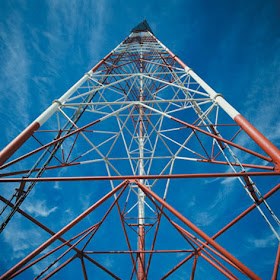 |
| BBC - Nakhon Sawan, Thailand tower |
According to a news release issued
by the BBC in London, the last day of operation for their relay station in
Thailand was December 31 last year, at the end of their lease which was not
renewed. The BBC states that they have
not been able to come to an agreement with the Thai government over programming
issues, but in any case the BBC has now closed the station due to financial
difficulties. Even this
station has been completely silent right throughout this year thus far, the
closure of this important BBC shortwave station seems to have largely escaped
the attention of the international radio world.
In our program today, we plan to present the story of this BBC Far East
Relay Station during its nearly ten year operation from Hong Kong, and in a
coming program, we plan to present the story of their subsequent station in
Thailand.
Planning for the Hong Kong relay
station began during the 1970s. However
in 1981, the Managing Director of BBC External Broadcasting, Douglas
Muggeridge, expressed frustration that the entire project may be abandoned due
to unavailability of funding.
Nevertheless, even though it was
known in advance that the station could expect a life span of no more than ten
years, the managing authorities finally decided to go ahead with the project in
Hong Kong while planning also for the construction of a subsequent station in
another at the time undetermined country.
The location for the new BBC East
Asia Relay Station was in an area of undeveloped jungle in the New Territories
at Tsang Tsui, some 75 miles north west of downtown Hong Kong. It was an isolated location with no nearby
public transportation.
A very compact site was chosen for
the construction of the transmitter building and the erection of five self
supporting antenna towers. The towers
were arranged in an east-west row and they supported four multi-band curtain
antennas with passive reflectors.
Each antenna could be slewed
electronically at plus or minus 14o for coverage into northern China and
Japan. A row of hills obstructed
propagation to the south, but in any case the station was needed for
programming only to the north.
Construction work at the Hong Kong
transmitter site began in February 1985 at a total cost of $11 million. Two Marconi transmitters at 250 kW, Model
B131, were installed and the first test transmission began more than two years
later at 0400 UTC on August 6, 1987 on 15280 kHz. Full time operation began six weeks later on
September 27.
Programming delivery from London was
by satellite to Hong Kong Telecom and then by fibre optic cable to the
station. Programming was broadcast in
three major language streams, Chinese, Japanese and English, with two programs
on the air simultaneously at any one time.
The station was an efficient
computer controlled unattended operation with only twelve employees, just one
of whom was a foreigner, a BBC manager from England. As a touch of humor, it was stated that the
local protective dog was also a BBC employee, due to the fact that the manager
fed it from BBC funding.
On the political scene, it was
agreed that the one time British colony of Hong Kong would revert to China in
June 1997. Consequently, the BBC planned
to remove and ship out all usable equipment and demolish the building in
advance of the transfer of the territory to Chinese sovereignty.
The final broadcast from the BBC
East Asia Relay Station in Hong Kong occurred at the end of November 1996. The actual location of this shortwave station
seems to be a green area among the jungle trees, visible on Google Maps at 113
55 18 57 E & 22 25 04 02 N.
Many QSL cards were issued from the
BBC East Asia Relay Station, quite often local Hong Kong postcards with a
rubber stamp on the text side containing the QSL details. At one stage, a printed QSL card showed a
photo of the antenna system at Tsang Tsui.
Two months after the station was
closed, the towers were down and the two transmitters were already crated,
ready for shipment to another destination, which turned out to be a new BBC
station in Thailand. And that station is
now also off the air. The story of this
station is planned as our topic here in Wavescan, quite soon.
(AWR Wavescan/NWS 247)